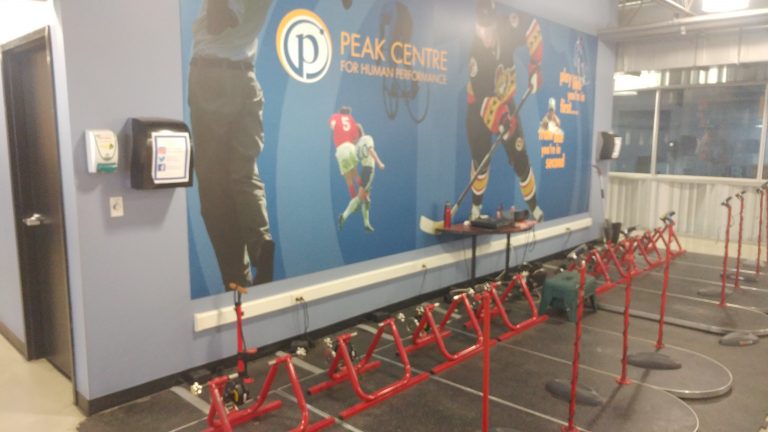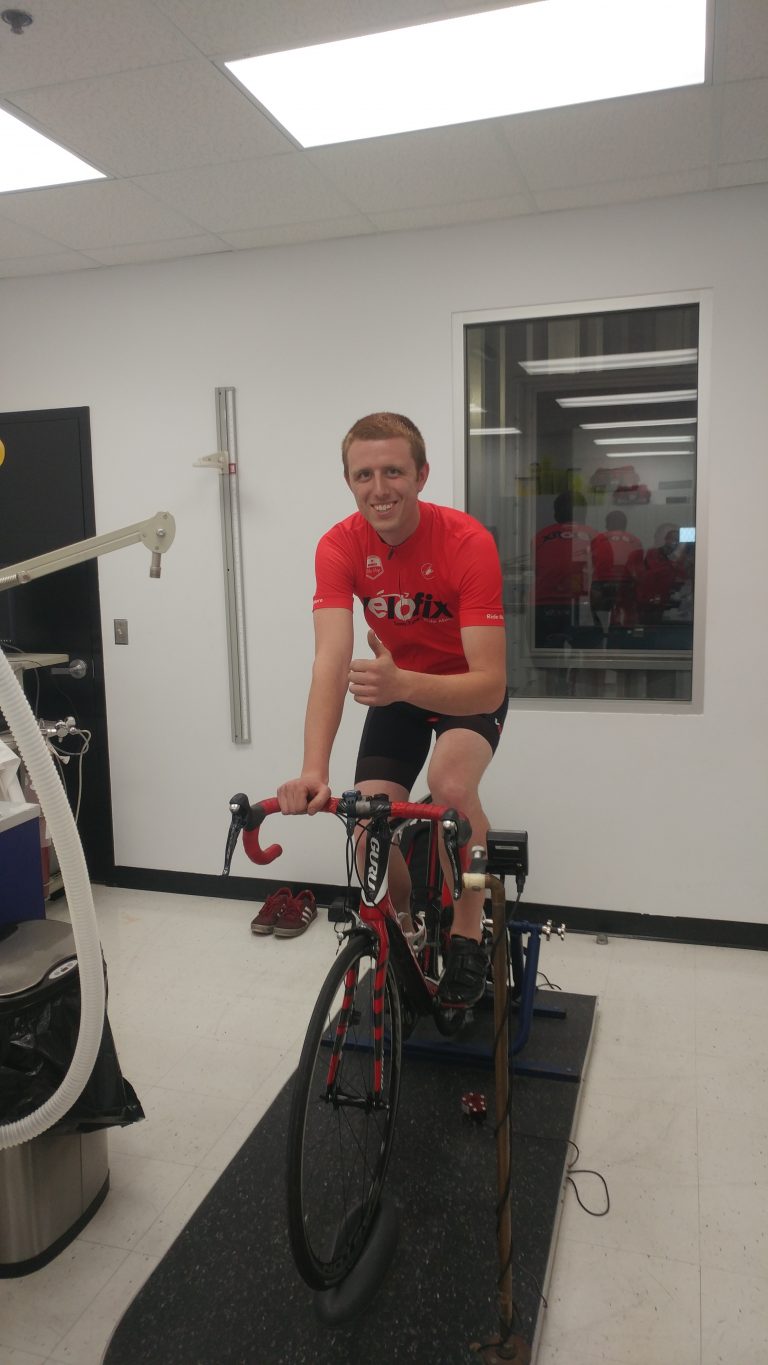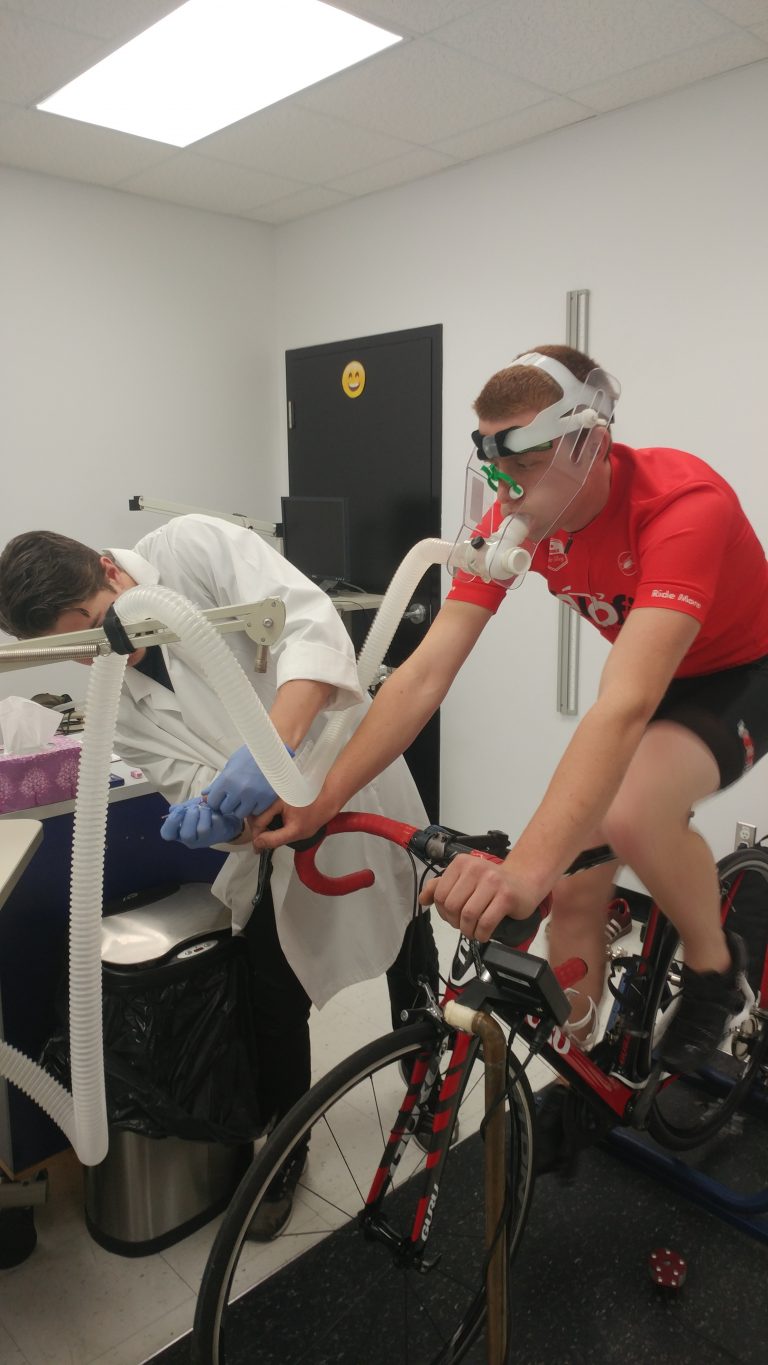Business Review: Peak Center
Long before I started cycling, before velofix, before the spandex and the obsession with carbon fiber – I was passionate about exercise physiology.
Next time you peek into the velofix van, you might see a few diplomas and certifications on the wall. If you look waaaay down, you might see that I studied science and kinesiology in University. During my time there, I fell in love with sports from 3 different angles:
- I played on a few different club & varsity teams. I learned a lot by being an athlete and training competitively. I played volleyball in my first year then did track & field, cross country and swimming for uOttawa in my later years.
- I worked for the school’s Sports Services Department as a student athletic therapist. I got to work for the other varsity sports teams and saw a whole new side of sport.
- I was a “guinea pig” for the Human Exercise Physiology Research Unit (HEPRU) and was able to participate in over a dozen studies related to exercise physiology.
During my time at HEPRU, I got to undergo dozens of different tests to see how the body reacts to different conditions. I can remember doing treadmill runs in 100% humidity, doing VO2 max tests, negative pressure tests (look that one up!) and so much more. I really loved being a part of the learning process and helping friends/colleagues of mine with their Masters and PhD programs. I got to read the abstracts, learn about what they were trying to learn about – then see what they learned from testing me.
I graduated from University in 2013 but I’ve continued to volunteer for trials and studies every year since. Because of this deep love for learning and a passion for performance, I reach out to Peak Center.
From the beginning and from anyone I’ve ever spoken to in that world – Peak Center is the gold standard for anyone who wants to assess and improve their fitness level. I reached out to them asking if I could get a tour of the facility and undergo a specific fitness test that I had never done before: a Cycling Threshold VO2 Max Test.
The Walk Through:
Peak Center is in Ottawa’s West end, on the 2nd floor of the Bell Sensplex. The Sensplex itself is stunning but Peak Center holds themselves to a higher standard. Their facility was clean, organized and had the friendliest staff BUT the most impressive part was their state-of-the-art equipment and tools.
For the cyclists reading this blog, there were 8 Computrainers set up, along side 13 Lemond Spin Bikes. They also had an impressive weight room and a laboratory.

The Set up:
My Threshold Testing was done by a young sports scientist named Luke. I had never met Luke before or done this specific protocol/test. This test requires a lot of effort, and there’s some minor blood work (more to come), so I put Luke through a bit of a stress test before starting the protocol. Not to be a know-it-all, but Luke had all the right answers at his fingertips. Everyime I’d ask about the process, the metrics, his background, or general sport science questions – he was quick and confident. In short, he passed the “Adam test” and we were ready to start the test.
One thing I really liked about this test was that I could use my own bike. I didn’t have to use a piece of gym equipment or something generic. Luke set up my bike and he handled it with care. My bikes are all pretty special to me and I was really appreciative of how Luke handled my machine.
He calibrated the Computrainer, set up the cadence sensor and hook me up to a heart rate monitor via a chest strap. After a quick warm up, he recalibrated the Computertariner, because (according to him) the molecules of the tire get hotter and test different once they’ve been warmed up. Sure enough, the second calibration was 10% different than the first – kudos Luke! I had never heard/though of doing a second calibration with a rear-wheel trainer. It makes sense to me and it was really neat to see a tangible difference pre and post warm up.

The Test:
For this protocol, I had to ride continuously, at a cadence of 85 RPM. The cadence can be chosen by the cyclist but cannot be changed once you start the protocol.
I started riding at 120 Watts (again, that number is rider specific) and it went up by 30 Watts every 3 minutes. In addition, they took a tiny blood sample every 2 minutes. They used a small finger prick at the beginning of the test to give themselves a way to draw a small sample every 2 minutes. In a comical moment, Luke told me he was going to use a small eraser sized box to prick my finger and counted down from 3. After the countdown I honestly thought the box didn’t work and I asked if he had to try again. As it turns out, the finger prick was so pain-free, I didn’t realize it had happened. The hole was so small that no blood actually came out, unless Luke massaged my finger tip and pushed blood out. There was no pain, no bruising and no blood on my bike (the most important to me! haha).
The blood they collected was used to calculate Lactate Threshold, which is a metric that can be really important for performance, but often difficult to get. Once you know where your lactate thresholds are, you can then plan your training efforts properly and know how hard you can push yourself in training or competition.
I was told to ride until:
- I gave up
- I couldn’t maintain the 85 RPM cadence
For 21 minutes, I sat on my bike and pushed the pedals. I had the monitor in front of me, so that I could see everything my body was doing: heart rate, oxygen intake rate, CO2 output, breathing rate and another dozen metrics that I quizzed Luke about. Once again, he knew every number on that screen and I was in good hands.

The Results:
After the trial was done, Luke and I went over the protocol, we talked about the numbers on the screen, we talked about the data, how I was feel and how I felt about my effort level. With a quick post-interview, they let me shower, get changed and sent me on my way.
A few days later, Luke’s full report came in. If you were impressed with the information above – wait until you see what the report included. 6 full pages of personalized data and information. Inside, it summarized all the data they collected during the trial, so I could see how I did during the ride. A little further down, Luke summarized my training zones. If you’re into performance sports, especially cycling or triathlon – you’ve likely heard of your “zones”. There’s typically 5 zones: 1 to 5 (easiest to hardest) and the harder you’re effort levels, the higher “zone” you’re in. Knowing how much time you can spend in each zone allows you give maximal effort without burnout.
The document goes on to explain:
- My individual training zones
- The number of calories and amount of carbohydrate I need for training and racing
- My efficiency and changes in efficiency
The information was perfectly detailed and explained in a way that any athlete could understand and utilize.
With this data, I now know how high I can allow my heart rate to get before I start seeing diminishing returns. I know what the number is for exercise that lasts anywhere between 30 minutes and 3 hours. I know what my training zones are and how my body perform in those training zones. Luke even went as far as to recommend fueling and refueling strategies for me, based on my results. He didn’t suggest any specific brands but was able to make great suggestions around what type of foods I should eat, and how much/frequently.
Overall, the process at Peak Center is something you have to experience for yourself. This blog post was not paid for and I’m writing it strictly because of how impressed by the process and team at Peak. Peak now does a lot of the testing for Triathlon Ontario and a few professional cyclists/triathletes. A lot of their staff are avid cyclists and have done everything from short course tri to Ironman.
If you’re serious about your performance, and if you want to train with a higher efficiency – do yourself a favor and contact Peak. https://www.peakcentre.ca/why-peak-centre/contact-us/
They have a range of different services that they offer – from testing to complete coaching programs. If you enjoy sport as much I as I, I’d at least suggest reaching out and asking them for a tour. You’ll get a chance to connect with some really passionate people and talk about performance with the best of them.
Thank you to the team at Peak for letting me come in and tour their facility. Thanks for being patient with all my questions, all my nerdy-ness and thank you for being such professionals throughout the whole process. I’ll be back soon for another round of testing after I use your data to get in better shape!
If you, the reader, have any questions about my experience, please let me know. I can be reached at Adam@velofix.com